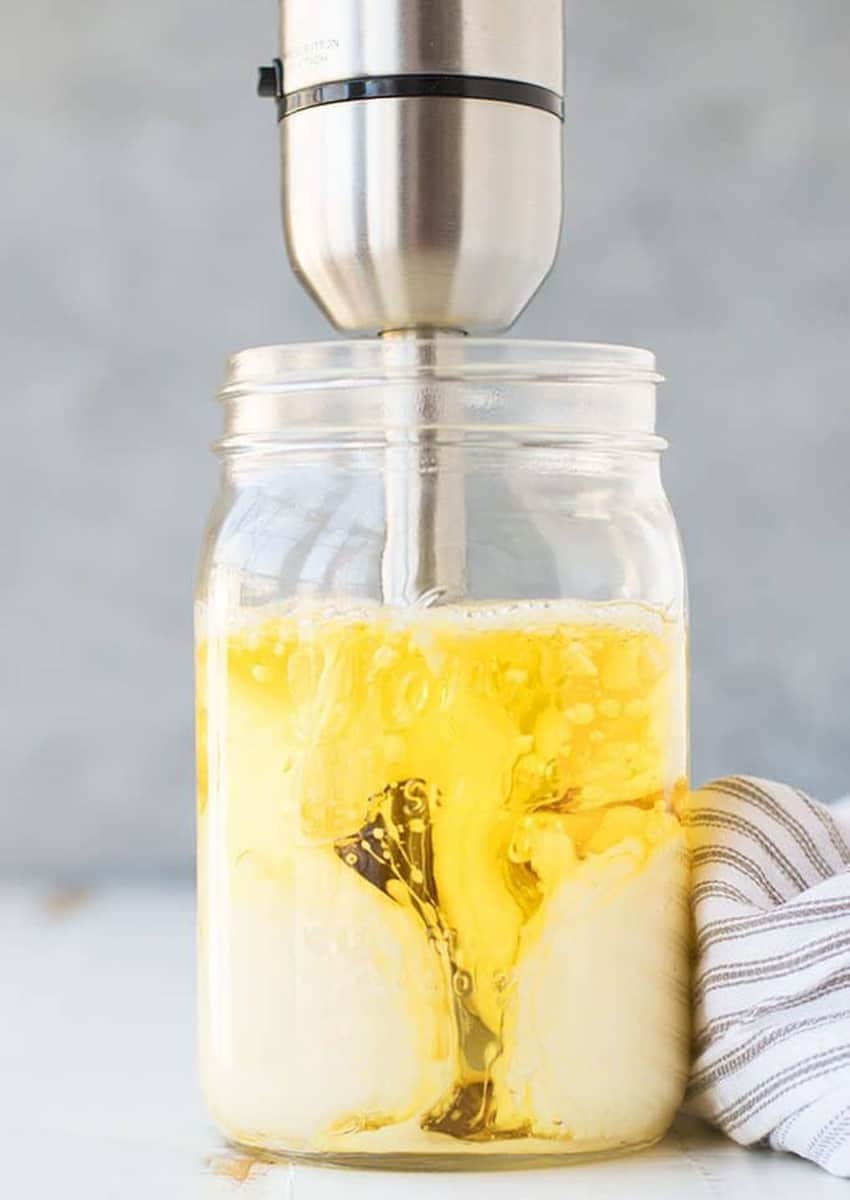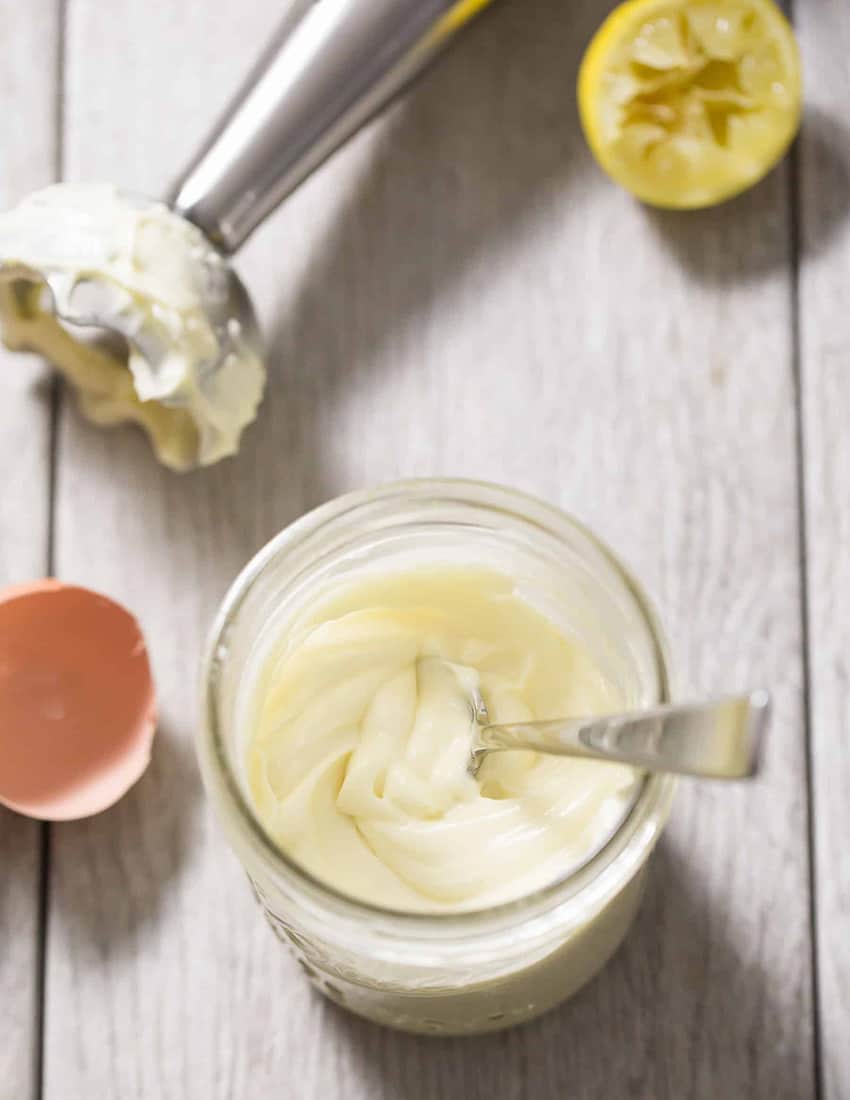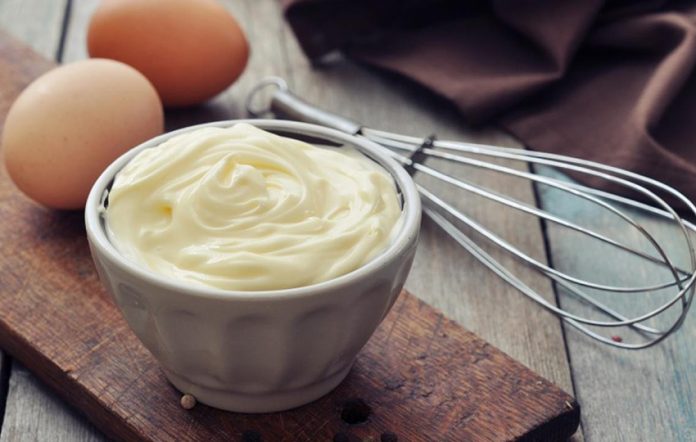I’ve always been afraid to try to make mayonnaise. Even though chef friends said it was easy, and even though I’d watched numerous videos and cooking shows where both everyday folks and professionals turned eggs and oil into creamy aioli, I was sure it wouldn’t work for me. It would curdle or separate or just be glop.
All of that changed once I got an immersion blender. Now I make perfect delicious mayonnaise in literally a couple of minutes. It’s so easy, it’s ridiculous!
This short video shows you how.
There are some differences: mayo whisked by hand will be glossier and more of a sauce, and one made with a machine (a blender or food processor) will be thicker and creamier. But both are delicious; you choose.
Who came up with the idea to make what we know as mayonnaise? A handful of theories trace it to mid-1700s France, when references to an olive oil-based sauce began to appear in various accounts.

Food historians point to bayonnaise, a specialty sauce of Bayonne, in the south of France, and say the word was eventually modified to “mayonnaise.” Others say it comes from the Old French word moyeu (egg yolk) or the word manier (to stir).
Whatever the case, it was as popular then as it is now and became a favorite all over Europe. Mayonnaise made its American debut in 1913 thanks to a German immigrant named — you guessed it — Richard Hellmann, who owned a deli in New York City.
The recipe for the creamy condiment actually came from his wife, Margaret Vossberg, who learned it from her mother, but credit was not given to either of the women until last year on International Women’s Day, when the company finally acknowledged their role in the creation of this timeless favorite.
Some tips: it seems that lemon juice makes the finished mayo taste better than lime juice; it’s subtle, but there is a difference. So do splurge and get yourself a limon amarillo if you can.
Also, be sure to use fresh oil — I’ve had the unfortunate experience of using slightly turned oil that probably sat on the shelf in my local tiendita for a few too many hot days and nights. It imparted a musty taste to the finished product that was distracting and irritating. Not rancid, just too noticeable — in a bad way.
And although one might think olive oil is the thing to use, the pros say a neutral oil (canola, vegetable) is best, as olive oil can get bitter when it’s blended at high speeds. (Unless you’re whisking it by hand, in which case olive oil will be fine.) Or use a mix: start with a neutral oil, and once it’s emulsified and stable, add some extra-virgin olive oil for flavor.
To all of you Kraft Miracle Whip lovers: It’s not mayonnaise, although you may use it as such. It’s got a cooked base and is legally labeled “salad dressing” as it doesn’t meet the standards for mayonnaise.
Two-Minute Mayo
- 1 whole egg
- 1 tsp. Dijon mustard
- 1 Tbsp. lemon* juice for acidity
- 1 cup neutral oil (canola or vegetable; olive oil gets bitter when mixed at high speeds)
- Salt and pepper to taste
- Optional: 1 clove minced garlic
*You can use fresh lime juice instead but may need more than 1 Tbsp.
Using immersion blender, lower it all the way to the bottom, turn on to mix all the ingredients. As it spins, it draws the oil down. Slowly lift it and voilà! Fresh, tasty, beautiful mayo! — www.seriouseats.com

Vegan Aquafaba (Chickpea) Mayonnaise
Aquafaba is the protein-rich liquid in a can of chickpeas.
- 2 medium cloves garlic, minced
- 1 Tbsp. fresh lemon juice
- 2 tsp. Dijon mustard
- 3 Tbsp. liquid from 1 can of chickpeas, plus 12 whole chickpeas
- ½ cup vegetable oil
- ¼ cup extra-virgin olive oil
- Salt and freshly ground black pepper
With an immersion blender: Combine garlic, lemon juice, mustard, aquafaba and chickpeas in a tall container just large enough to fit the head of an immersion blender. Blend at high speed until completely smooth.
With a regular blender: Place garlic, lemon juice, mustard, chickpea liquid and chickpeas in blender and process till smooth.
Next, with blender running, slowly drizzle in vegetable oil. A smooth, creamy emulsion should form. Using a rubber spatula, transfer to bowl.
Whisking constantly, slowly drizzle in olive oil. Season with salt and pepper.
Store in covered container in the fridge for up to 1 week.
Classic Mayonnaise
Careful! If you add the oil too fast, it will separate. “The first 30 seconds of adding the oil are the most crucial,” says chef Gordon Ramsay.
- 2 egg yolks, at room temperature
- 1 tsp. Dijon mustard
- 1 Tbsp. fresh lemon juice (or white vinegar)
- 1 cup neutral oil (canola, vegetable)
- Salt and pepper
In a bowl, whisk yolks, then drizzle in oil very slowly. Once it starts emulsifying you can add the oil more quickly. Whisk for 3–4 minutes, then whisk in lemon juice and then mustard. Once thickened, add salt and pepper.

Making mayo in a blender/food processor:
- 1 egg
- 4 tsp. freshly squeezed lemon juice
- 1 tsp. Dijon mustard
- Salt and pepper
- 1 cup neutral oil
Process egg, lemon juice and mustard until well combined. With the motor still running, add the oil in a very slow, thin, steady stream and blend until mayonnaise is thick and smooth. Add salt and pepper to taste.
Add any of these flavors after your mayo is done:
- Garlic aioli: add finely minced garlic
- Sriracha aioli: add sriracha and lime juice to taste
- Remoulade: add cornichons, fresh dill, capers, garlic and cayenne pepper
- Lime: add minced red onion, lime juice and garlic
- Chipotle/jalapeño: add minced canned chipotles or jalapeños.
Have you ever tried making your own homemade mayo? Did you find it worth the effort? We’d love to know!
Janet Blaser is the author of the best-selling book, Why We Left: An Anthology of American Women Expats, featured on CNBC and MarketWatch. She has lived in Mexico since 2006.
